Crime
Karl-Heinz Wemhoff, Master Check-Kiter
Here is an account of a bold check-kiting scheme that probably would not be possible nowadays. As with many of these crimes, it sounds like it was more work than making an honest living.Original article here.


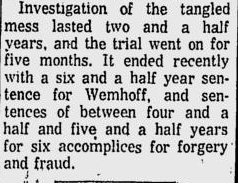
Posted By: Paul - Mon Mar 26, 2018 -
Comments (2)
Category: Crime, Money, 1960s, Europe
Swallowed the evidence
In November 1965, Walter Cunningham was arrested on suspicion of being involved in a jewel robbery. The police picked him up two days after the robbery, loitering outside a pawn shop. He didn't have the jewels on him, but when he later complained of a stomach ache, the police realized he had swallowed all the evidence: about 91 diamonds, a 20-karat ruby, and an emerald chip.Police Lt. Carl Schumacher told reporters, "We figure he must have swallowed the gems while he was being booked. He was probably standing there chomping away while our backs were turned."
Doctors subsequently recovered the jewels. Cunningham pleaded guilty to a federal charge of interstate transportation of stolen property.
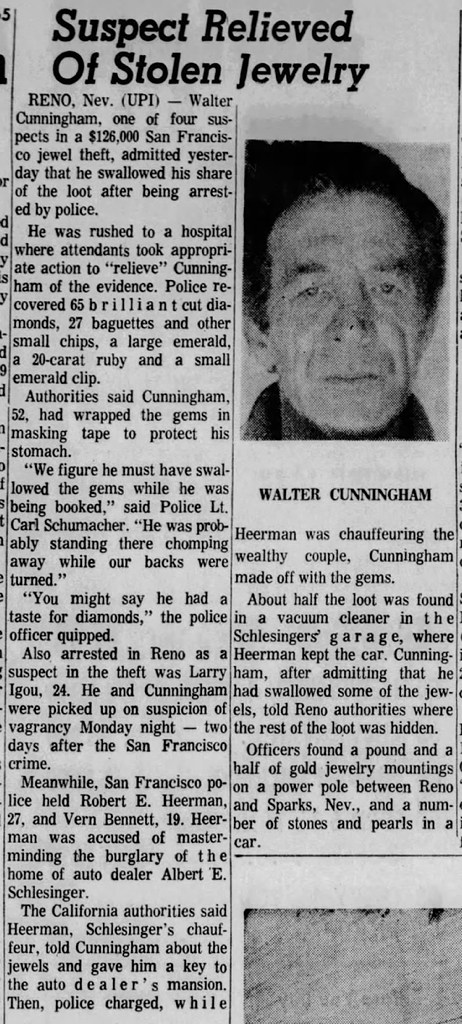
Santa Rosa Press Democrat - Nov 19, 1965
Posted By: Alex - Mon Jan 29, 2018 -
Comments (2)
Category: Crime, 1960s
Librarian Strikes Back
In February 1961, Harold Roth, director of the East Orange Library in New Jersey, made news by having arrest warrants made out for 14 people with overdue books. The degree of overdueness ranged from four months to one year. But what really attracted attention was the manner of the arrests. The police showed up at many of the houses around midnight to rouse the scofflaws out of bed and drag them down to jail.I think this 1961 case remains the largest mass round-up of people with overdue library books, but people still occasionally get arrested for not returning their library books in a timely fashion. The site publiclibraries.com has an article about "Jail time for overdue library books" that lists some more recent cases.

Life - Feb 17, 1961

Green Bay Press-Gazette - Feb 8, 1961
Posted By: Alex - Wed Jan 24, 2018 -
Comments (10)
Category: Crime, Libraries, 1960s
Cool Breeze
"Cool Breeze is cold business!"
Extra points for the lead actor's extra-juicy name: Thalmus Rasulala.
Wikipedia entry.
Posted By: Paul - Sun Jan 14, 2018 -
Comments (1)
Category: Crime, Movies, Stereotypes and Cliches, 1970s
Mongolian Box Prison

Source of photo.
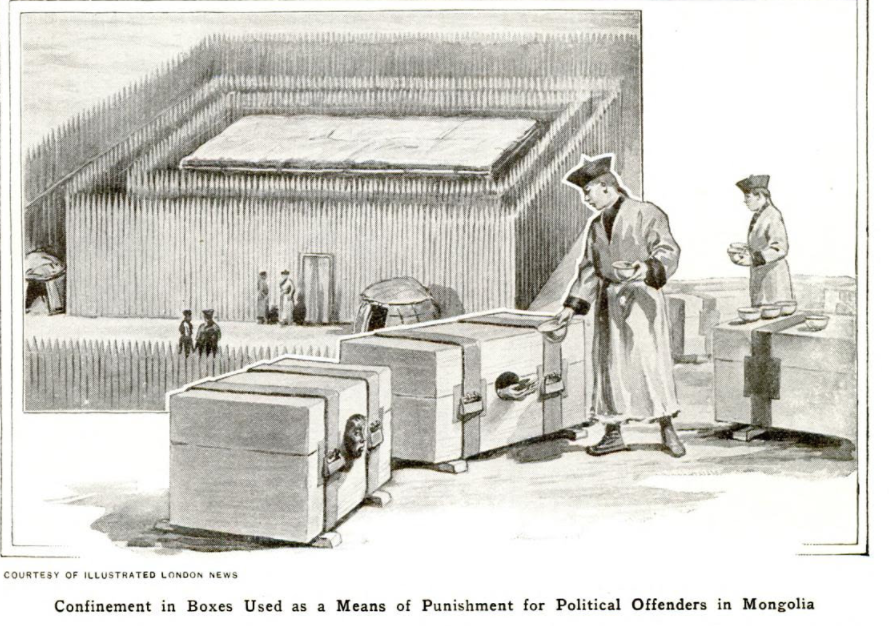
Source of drawing.

Posted By: Paul - Thu Jan 04, 2018 -
Comments (7)
Category: Crime, Death, Dictators, Tyrants and Other Harsh Rulers, Prisons, 1910s, Asia
The Untouchables vs. the Touchables

One of Eliot Ness's less well-publicized duties.
Posted By: Paul - Tue Sep 19, 2017 -
Comments (1)
Category: Crime, Medicine, Sexuality, 1940s
More stolen lampposts
Phideaux draws our attention to yet another attempt at stealing lampposts by strapping them to the roof of a car. In Florida, this time. A month ago it was the Netherlands.
Posted By: Alex - Thu Sep 14, 2017 -
Comments (3)
Category: Crime, Cars
Insane Killer Dynamited in His Fortress
In earlier eras, there were different strategies for ending a siege than what we are accustomed to today.
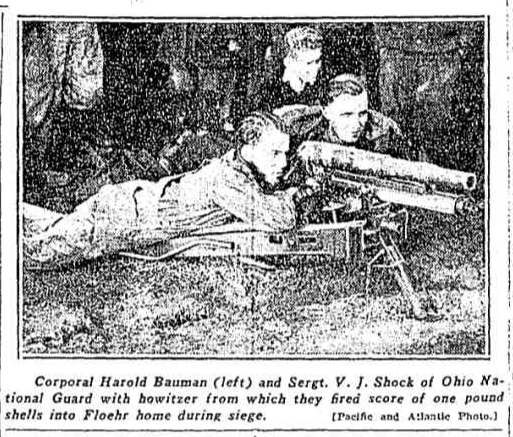
Source of fotos.
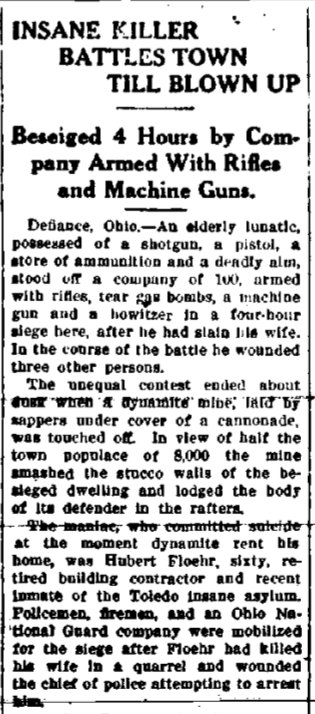
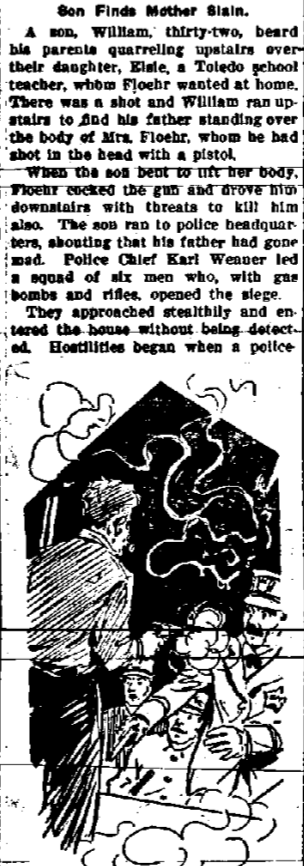

Posted By: Paul - Tue Aug 29, 2017 -
Comments (7)
Category: Crime, Scary Criminals, Death, Destruction, 1930s
Stolen Lampposts
Police in Lelystad (the Netherlands) arrested a man who was driving with two stolen lampposts strapped to the top of his car. They posted the following picture to their Facebook page.
Google Translate provides the following translation of the picture's caption (and I think Google translate has been getting better lately, because this translation is fairly comprehensible):
We start with the traffic violations. That the cargo can not be transported in this way may be clear. In addition, the car was not insured and the APK had been running for more than three months. The driver's license B was declared invalid by the end of 2016. The colleagues smoke with the driver an alcoholic air. However, he refused to cooperate with a blow test on which he was arrested. Expectation is that the court will demand the highest possible penalty for driving under the influence of alcohol because the suspect did not cooperate with the investigation.
The investigation investigated the origin of the lampposts. These are most likely stolen in Almere. In addition, there appeared to be other criminal investigations to the suspect, such as refueling without paying.
The suspect is embedded in the cell complex and has now been insured. The car has been seized.
In summary, seems that the guy was drunk, uninsured, had an expired driver's license, and was driving around with two stolen lampposts on top of his car.
My question is, what was he planning to do with the lampposts?
Posted By: Alex - Sat Aug 05, 2017 -
Comments (6)
Category: Crime, Stupid Criminals, Cars
The Takeaway Rembrandt
In 1632 Rembrandt painted a portrait of Jacob de Gheyn III, an engraver living in Utrecht. The portrait is quite small, measuring approximately 12 by 10 inches. As a result, it's relatively easy to steal and has earned the nickname "The Takeaway Rembrandt" because of the number of times it's been swiped.From wikipedia:
Between 14 August 1981 and 3 September 1981 the painting was taken from Dulwich Picture Gallery and retrieved when police arrested four men in a taxi who had the painting with them. A little under two years later a burglar smashed a skylight and descended through it into the art gallery, using a crowbar to remove the painting from the wall. The police arrived within three minutes but were too late to apprehend the thief. The painting was missing for three years, eventually being found on 8 October 1986 in a luggage rack at the train station of a British army garrison in Münster, Germany.
The other two times, the painting was found once underneath a bench in a graveyard in Streatham, and once on the back of a bicycle. Each time the painting has been returned anonymously with more than one person being charged for its disappearance.
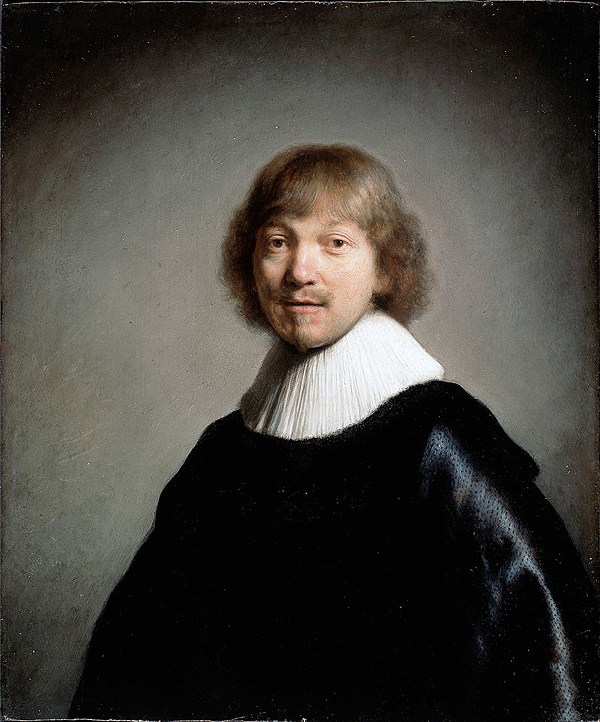
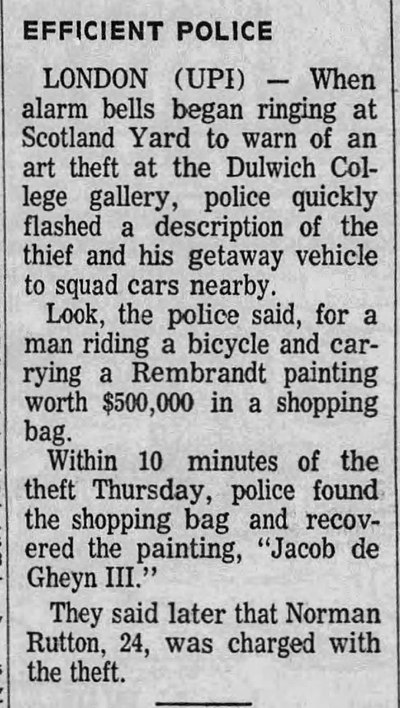
St. Cloud Times - Feb 17, 1973
Posted By: Alex - Thu Jun 22, 2017 -
Comments (4)
Category: Art, Crime, 1970s

| Who We Are |
|---|
| Alex Boese Alex is the creator and curator of the Museum of Hoaxes. He's also the author of various weird, non-fiction, science-themed books such as Elephants on Acid and Psychedelic Apes. Paul Di Filippo Paul has been paid to put weird ideas into fictional form for over thirty years, in his career as a noted science fiction writer. He has recently begun blogging on many curious topics with three fellow writers at The Inferior 4+1. Contact Us |




